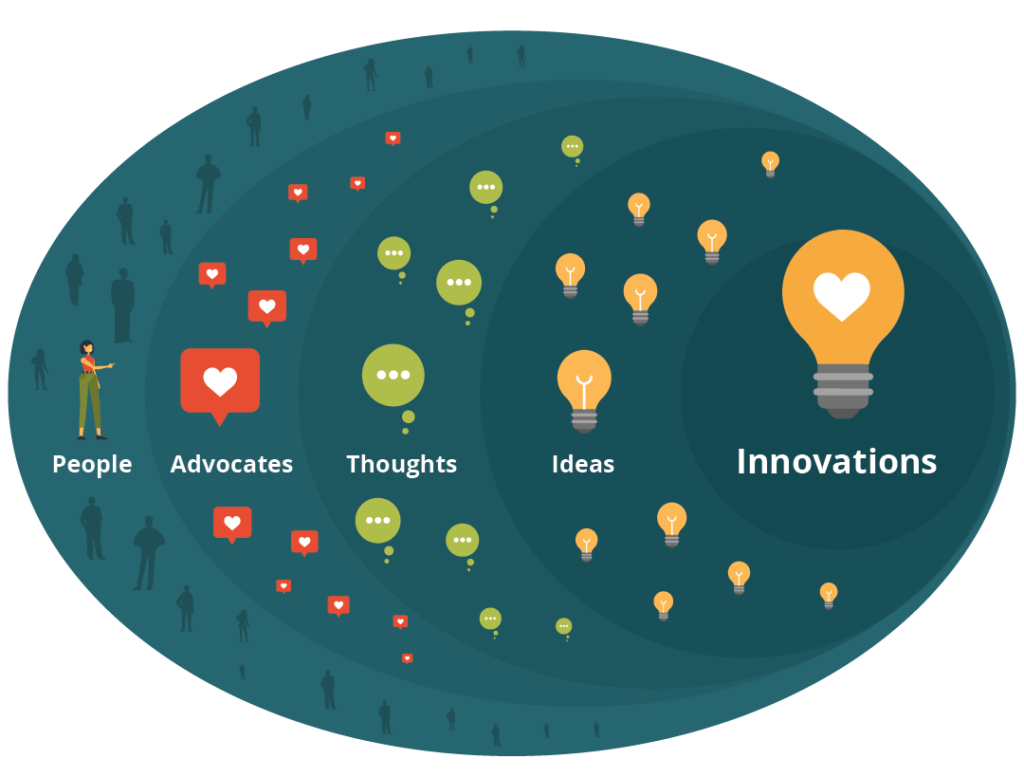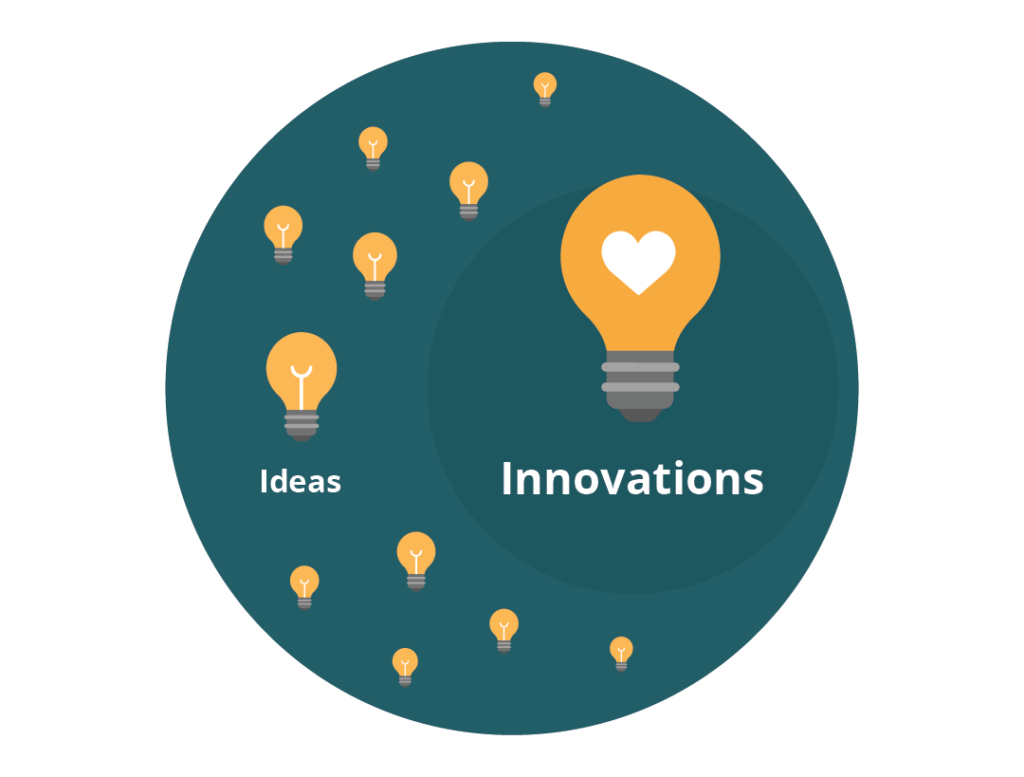In this blog, ITX EVP of Innovation Sean Flaherty explores where innovation comes from, discusses obstacles that stand in its way, and offers a simple technique you can share with your teams for capturing ideas that lead to more innovations.
This blog is a refreshed version of the original, which was first published February 15, 2022, on Medium.
In building a culture of innovation, teach your leaders to write down their ideas, lest they get lost in the clutter of their minds.
Innovations Come Only From People

Innovation doesn’t have to be disruptive to be impactful. Some, as Dr. Timothy Clark shared, “ are light bulb moments of lone genius.” But most of the time, he adds, “it’s a collaborative enterprise where we are all working together.” In other words, even small innovations can add up over time and lead to a sustainable and hard-to-copy competitive advantage.
But let’s back up for a moment and talk about how leadership and creativity intersect. I believe leadership is a function that initiates an environment where creativity thrives for the people being led. It’s an art that leadership fosters an environment where meaningful innovations occur with regularity.
The Function of Leadership Inspires Creativity

If you need creativity at scale, you need leadership; if what you need is a process to be followed, you need management.
If the environment is perfectly predictable and you need to continue to do the same things in the same way, managing your team for efficiency is all that is required. The environment does not require leadership if you know exactly what is expected.
However, if the environment is volatile, uncertain, complex, or ambiguous (VUCA), creativity is required, and hence, you need leadership to ensure the environment is optimized to find your way through the fog.
Leadership is the function that continuously looks at the environment to optimize for the creativity of the people in the system. It can be broken down into four primary jobs, as explained by The Momentum Framework: Vision, Motivation, Capabilities, and Execution. The result, when firing on all four cylinders, is improved creativity in the pursuit of a worthwhile set of business goals.
To be clear, when I use the distinction of “innovation,” I mean:
An idea, tactic, or process improvement that enhances relationships with the people in your ecosystem.
In the traditional sense, it may mean that you have implemented a change that makes the whole ecosystem more efficient and more profitable, thereby improving your relationships with shareholders. Or, it may make your product or service much more attractive to your chosen market of customers, improving your ability to retain them and convert them into advocates.
In a less traditional sense, innovation may be an improvement in your team’s ways of working. When a team can reduce the friction within it, the experience each member has with your organization improves, which positively impacts retention and your ability to earn advocacy from your team.
Either way, every micro-innovation matters. They accumulate over time. And it is these ongoing improvements that ensure an organization remains adaptable and resilient to changes in the environment.
Innovations Come Only From Ideas

If you lead an organization long enough, you learn that most of the ideas you hear from the people around you are mediocre, at best. Most ideas are well-intentioned, but when you experiment with them in the wild, they bear little fruit.
After having worked in the software development industry for three decades, I can affirm this to be the case. Many features end up buried inside complicated menus and are rarely put to use. In my experience, this phenomenon approximately follows Pareto’s principle that 20% of software features get 80% of the usage. In fact, according to The Standish Group, many get no usage at all.
So where do ideas come from?
I assert that ideas come only from thoughts. At least for now, only people have thoughts with the potential to be innovations. It thus follows that only people who care about your future to some degree will share those thoughts and ideas with you, giving you the opportunity to consider, refine, and experiment with them.

People > Advocates > Thoughts > Ideas > Innovations
Daniel Kahneman and Amos Tversky, in studying human evaluation of moments in their research on decision making and memory, determined that the “experiencing self” has a complete thought about once every three seconds.
Each moment of the experiencing self lasts about three seconds.
Here is a mathematical thought experiment to consider. My teams run workshops with client executive leaders to help them to create more customer empathy and create the space for innovations to occur. In those workshops, we typically have between six and sixteen leaders. But to keep the math simple, let’s assume we have 10 leaders in attendance for a particular workshop.
A handful of additional assumptions for our exercise:
>> If there are 10 leaders in the room, and
>> If we spend about 7 hours in the Workshop, and
>> If there are 3,600 seconds in an hour (there are), and
>> If we have a thought every 3 seconds (per Kahneman’s research)…
We generate 84,000 potential thoughts in a typical Workshop. (10 x 7 x 3,600) / 3 = 84,000
Now, we have to get creative and take some liberties to complete the thought experiment, so let’s make a couple of very conservative assumptions:
>> If we assume 84,000 ideas generated during a Workshop (see above), and
>> If we assume that 1 in 500 thoughts might be an idea,
That leaves us with 168 ideas to experiment with. In a day that has been reserved for the specific purpose of generating ideas, this seems reasonable (and probably a bit conservative).
>> If we further assume that 10% of our ideas might actually deliver incremental value to our ecosystem, we should emerge from the Workshop with at least 16.8 reasonable innovations.
That sounds amazing, right? You’d think, given those numbers, that we should be doing these workshops on a regular basis.
But experience tells us that it doesn’t work that way. Innovations are much more fleeting and far more rare in real life. Why?
I have a few theories; here are two of them:
- Psychological safety in these sessions is almost always lower than we think it is. Participants are sometimes afraid to make themselves vulnerable in front of their peers. Or maybe ideas they come up with have already been tried. Whatever the reason, they don’t feel comfortable sharing their ideas. And that’s a huge obstacle for innovation. This must be addressed to maximize innovation, but that is not the point of this article.
- Since we are recycling our thoughts about every three seconds, we have no shortage of ideas. But we lose them to our own rapid-fire neurology. This problem can be addressed with a simple habit change in the people you lead.
I assert that we can improve our odds of capturing more, great ideas from the people we are leading if we were to leverage something like Mel Robbin’s Five-Second Rule. Her claim is that if we don’t tie an idea to a specific action within 5 seconds, it will never happen. Her work deals with changing your automatic behaviors and the habits in your life that are not giving you the results that you desire. This is a similar argument.
If you can lead your team to create a habit of idea capture and sharing simply by writing down their ideas whenever and wherever they have them, you stand to capture more great ideas. This simple technique will invariably lead to more innovations.
One of the keys to this is to create an environment of “open awareness” around what is important. You can do this by setting meaningful goals.
Also, recognize that when people are fully aligned, confident, and committed to a shared goal, creativity can strike at any point and on any day. It is not restricted to the Workshop day.
If you are in the business of leading, write down ideas and turn the good ones into actions.
Teach your team members to do this too. Make it a shared practice and habit.
Leadership By Setting the Example
In summary, lead your teams by setting the example. Model the behaviors you want to see from them.
Keep a notepad by your side and create a habit of capturing your ideas when they happen. Encourage your teams to do the same, review all ideas periodically, and celebrate the practice.
The next time you lead a Workshop, share the math with them and get them to imagine how it might feel if they came out of the session with even eight new micro-innovations – only half of what we calculated above.
Then, after the Workshop, count up the ideas that the team shared and you will be surprised at the change.
References
The Momentum Framework, by Sean Flaherty (2021)
An Advocacy Strategy, by Sean Flaherty (2021)
The Pareto Principle, by Vilfredo Pareto (1896)
The Standish Group Benchmark Reports (2020 Chaos Study)
Psychological Safety Inspires Innovation, Product Momentum podcast (Feb 2022)
Thinking Fast and Slow, by Daniel Kahneman, PhD (2011)
The 5 Second Rule, by Mel Robbins (2017)
Is Too Much Psychological Safety Bad for Business, by Sean Flaherty (2020)
Unleashing Creativity and Innovation, by Sean Flaherty (2018)

Sean Flaherty is Executive Vice President of Innovation at ITX, where he leads a passionate group of product specialists and technologists to solve client challenges. Developer of The Momentum Framework, Sean is also a prolific writer and award-winning speaker discussing the subjects of empathy, innovation, and leadership.



